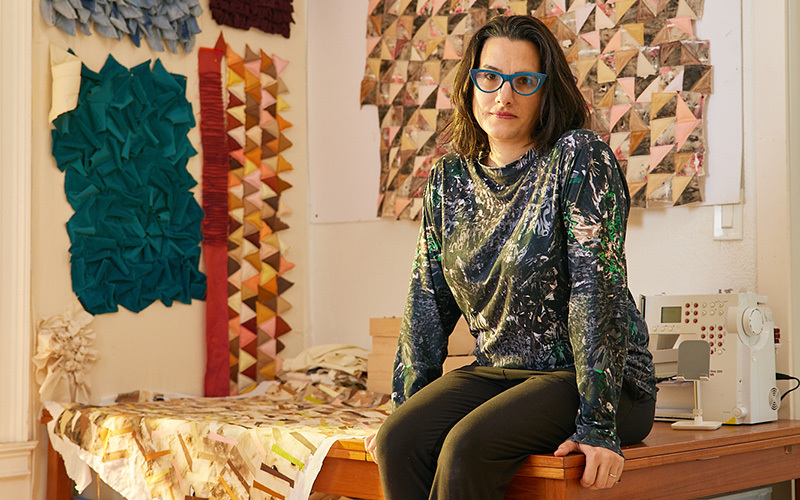 For Regina Jestrow, Miami is muse, inspiration, and home.
For Regina Jestrow, Miami is muse, inspiration, and home.
The textile artist Regina Jestrow loves Miami. The vibrant city she calls home is a patchwork of cultures, languages, peoples, and the exuberant natural landscapes of South Florida. When she makes her striking, geometric artworks, she can’t help but be informed by all the different influences that Miami brings to her doorstep.
“I draw inspiration from my city by weaving the colors, textures, and structures of the region into my work using a diverse palette of new, second-hand, and hand-dyed textiles,” Regina explains.
Her quilted pieces are deeply connected to their surroundings—made with hand-dyed fabrics created from local plants, rust, and other elements sourced from her environment—yet they also buzz with electric intensity, thanks to the repurposed fabrics woven into each composition. She’ll take an old pencil skirt, a vinyl tote bag, a men’s shirt from Zara, and with cuts and mends turn them into vibrant, living patchworks of cloth and artistry.
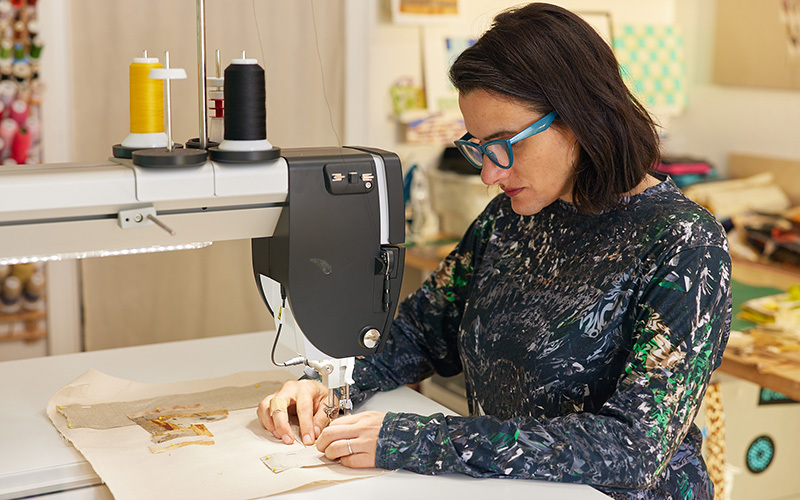 Regina makes work deeply embedded in the history of quilt-making, but from her own, contemporary perspective.
Regina makes work deeply embedded in the history of quilt-making, but from her own, contemporary perspective.
Looking at her practice today, she is a confident artist whose ambitions are expanding as she tries new techniques and seeks out new opportunities. But it wasn’t always this way.
“I have very little record of my earlier pieces,” she says, with regret.
“I wish someone had told me (or I wish I had the technology when I was younger) to document and record everything and to back up everything because computers die, phones get lost, and shit happens, and then you're lost.”
When it came to crafting the efficient art business she has today, she has learned that a stitch in time saves nine. “Maybe I found Artwork Archive when I started to take myself more seriously,” she explains.
In this edition of our Art Business Diaries, Regina reviews Artwork Archive and explains how she uses its quilt of artist-centric business tools to create the art career she always dreamed of.
Figure out what drives your artistic practice, and dig deeper into it.
Regina likes to think that, as a textile artist, she stands on the shoulders of all who came before her. “My work pays homage to American quilt-making traditions by playing with geometric patterns using stenciling, obsession, compulsion, precision, improvisation, spontaneity, and personal symbolism,” Jestrow explains.
She loves the deep history of American folk art quilt-making, and also draws inspiration from artist visionaries like the Gee's Bend quilters, Elizabeth Murray, Helen Frankenthaler, Anni Albers, and Gego.
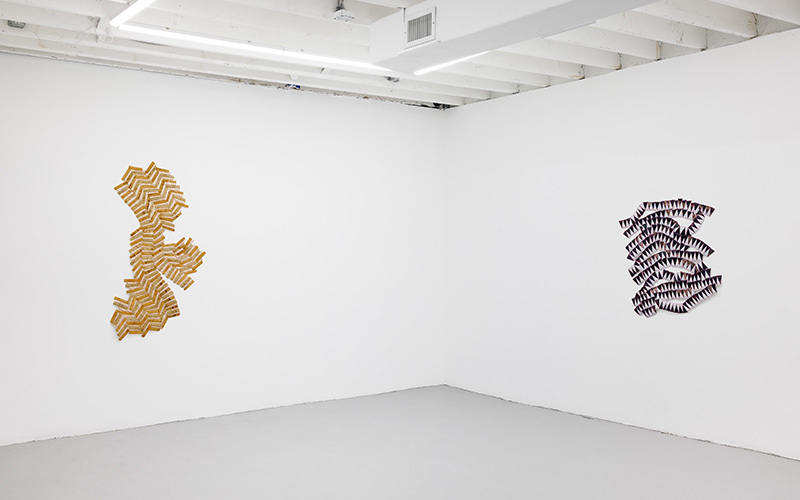 An installation of Regina's pieces "Glitter & Gold 11" and "Glitter & Gold 12."
An installation of Regina's pieces "Glitter & Gold 11" and "Glitter & Gold 12."
In many ways, her signature re-use of existing materials is a very contemporary, eco-informed twist on the resourcefulness of previous generations. “An integral part of my artistic ethos is consciously incorporating thrifted and second-hand clothing and fabrics,” Regina says. “By doing so, I aim to reflect Miami's culture and address the pressing issue of textile waste plaguing our society.”
Just as she "employs symbolic geometric quilt patterns as a foundation" for her textile work, she has established foundational practices for managing the business side of art using Artwork Archive. These patterns—consistent documentation, structured writing time, dedicated administrative time—create the framework that allows her creative freedom to flourish.
Prioritize organization, no matter where you are in your artistic career.
For Regina, the first sign that she needed a new way to organize her artistic career was that her existing patchwork of solutions wasn’t working.
“I started using Artwork Archive because I knew I needed to create a database and was getting frustrated with spreadsheets and creating my own PDF catalogs,” she says. “I was getting sloppy, and I wanted something professional and consistent-looking.”
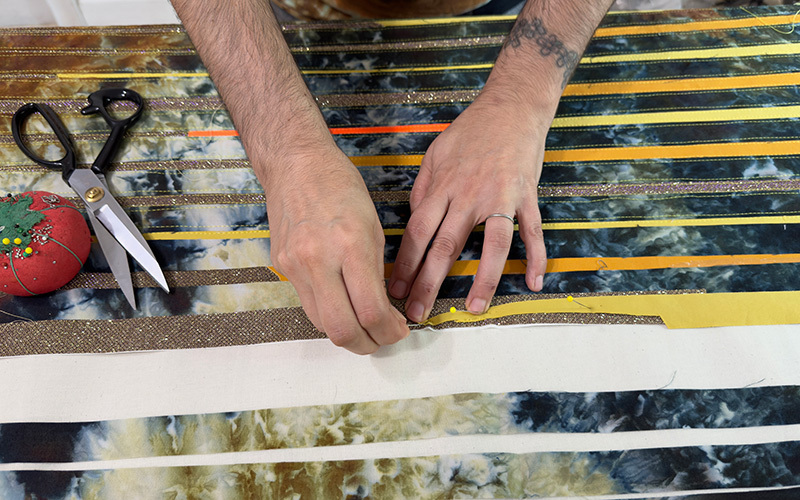 Regina's complex creations can combine re-used clothing, scavenged textiles, and hand-dyed fabrics into one exhilarating whole.
Regina's complex creations can combine re-used clothing, scavenged textiles, and hand-dyed fabrics into one exhilarating whole.
The precarious climate in Miami was also a concern: “I always worry about hurricanes, flooding, and leaking roofs in Miami,” she shares.
Once she made the switch to Artwork Archive, she found that she was able to do so much more than keep track of her inventory. Beyond the detailed piece records, she could create professional-looking portfolio pages, price lists, private rooms, and more. “I now use it for all my work every day.”
Make use of all the art business resources you have at your disposal.
Once Regina started digging into Artwork Archive a bit more, she realized how the service’s different organizational tools can serve specific and necessary functions in her art practice. Here are some of the tools she uses in her working week:
Catalog Pages
Regina uses Artwork Archive's catalog page reports as versatile tools that serve multiple purposes: "I use the sheets for labeling packaging for artwork being delivered so it's clear for the art handlers and recipients,” she says. “I also print the sheets to hang in my studio when I don't have access to the work, and I want to see it with other work in my studio. I also use the catalog pages to label work in my storage so it's easily identified."
“Plus, for folks who ask for a PDF portfolio, it's easy to put a catalog together with specific works for any opportunity.”
Inventory Reports
Exhibition preparation relies on Artwork Archive's inventory lists that serve as tactical guides: "I use inventory lists when setting up exhibitions and as checklists when preparing deliveries,” Regina explains. “The order of the items reflects the order in which pieces are hung on the gallery walls, so things get placed near where they are planned to be quickly."
Certificates of Authenticity
For sales, Regina creates unique certificates of authenticity, one of the cooler features that Artwork Archive makes available to all artists: "I use the certificate of authenticity for every piece I sell. I like putting all the details about the sale and body of work on one piece of paper for the collector." This documentation creates a lasting connection between artist and collector, extending the relationship beyond the moment of purchase.
Private Rooms
Regina creates private rooms within her Artwork Archive account to tailor a potential client’s experience of her work: “I use private rooms to share specific works with the curators, interior designers, and galleries.” She also uses private roooms to keep her gallery, Baker—Hall, up to date on available work in her inventory.
A peek into one of Regina’s custom private rooms:
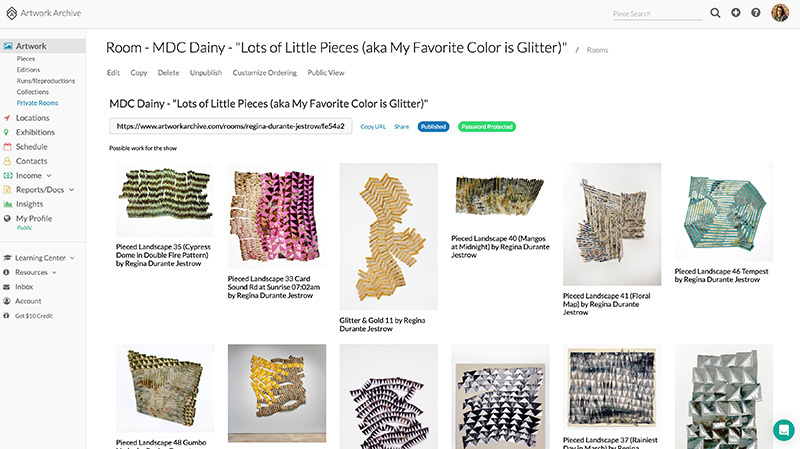
Tailoring your presentation to your audience is one easy way to stand out to collectors, galleries, and other clients. By creating a private room, Regina can quickly share a curated selection of works with anyone who might be interested in her work. Learn how to create your own private rooms with our helpful guide.
By weaving these different tools together, Regina is able to quickly and efficiently take care of her administrative tasks. But there’s more to an art career than being a good businessperson. You also have to be clear about why you’re making the work.
When it comes to writing about your art, get it out of your head and onto the page.
As a working artist, Regina needs to make sure she is reaching the right audiences for her work, but expressing herself in words has never come easily to her.
“Writing is very hard for me,” Regina shares, “but consistency helps clarify what I am trying to say (and so does Grammarly).”
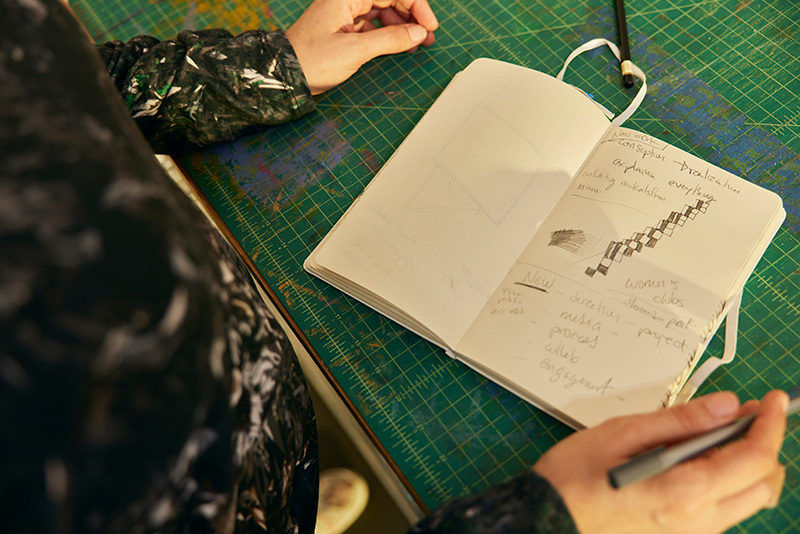 Getting your thoughts out of your head can illuminate new connections in your work, or spark an idea for your next piece.
Getting your thoughts out of your head can illuminate new connections in your work, or spark an idea for your next piece.
Now that she has Artwork Archive as her personal career tracking service, Regina can review all of the statements she has written for applications or shows, stored in Artwork Archive’s Documents section. She can store CVs, statements, artist bios, proposals, notable press clippings about her work, and any other documents that might be relevant to her practice.
“Writing clear statements about my work has helped me keep my work consistent by looking back at my specific goals and inspirations,” she said. “Writing about work and goals also helps get artist residencies, clearly communicate with gallerists and collectors, and has helped me keep my career on track.”
Find when you’re most productive for art business tasks, and stick to that time.
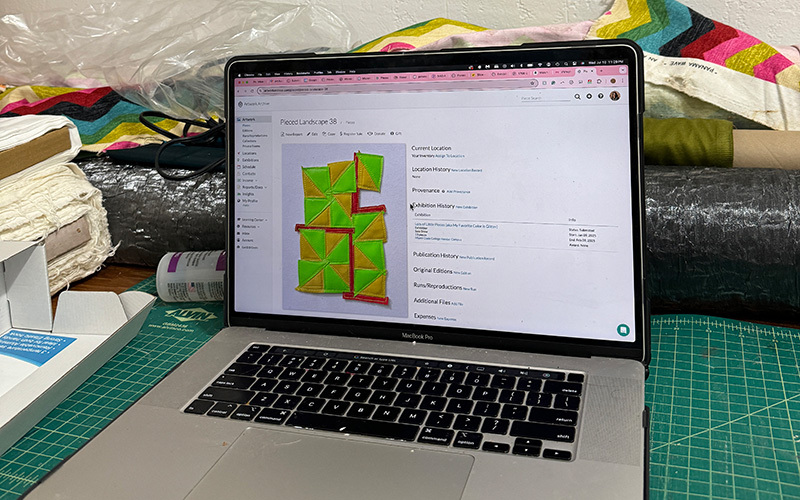 Find whenever makes the most sense for your administrative work, and stick to that time—it will pay dividends.
Find whenever makes the most sense for your administrative work, and stick to that time—it will pay dividends.
Even with Artwork Archive up and running, Regina still has to guard her creative time wisely. By clearly separating her art practice time from her administrative tasks, she can stay inspired in the studio.
“I usually manage the business side of things first thing in the morning and late in the evening,” Regina explained “My brain seems to be the clearest for computer work at those times of the day.”
Look at the big picture when it comes to your art practice.
Regina’s career is now composed of many elements: creative inspiration from Miami's landscape, technical skill developed over years of practice, writing that clarifies and communicates, organizational systems that preserve and protect, and promotional strategies that connect work with audiences.
Each element alone might seem purely functional—just as a single square of fabric might not look like much on its own. But when integrated thoughtfully into a larger composition, these pieces create something both beautiful and practical—a sustainable artistic life.
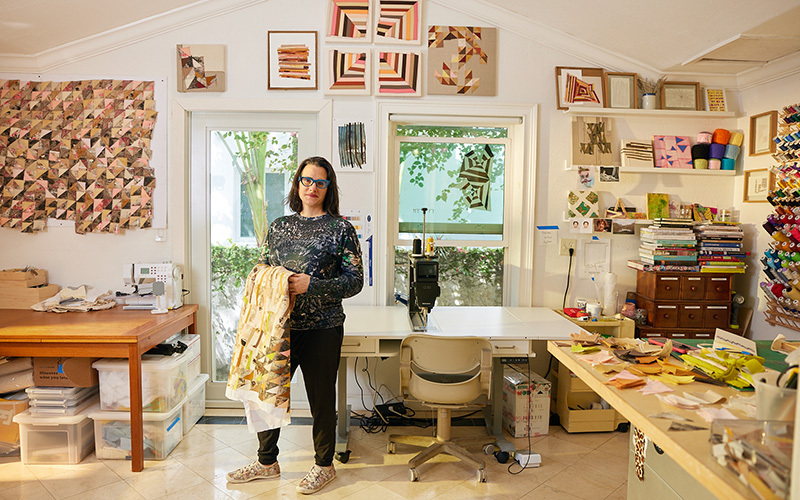 Regina is grateful for her beautiful home studio.
Regina is grateful for her beautiful home studio.
"I think Artwork Archive is great for any type of artist, from jewelers to monumental land artists," she concludes. "It's just an easy, clean way to record and save documentation of your work, process, exhibitions, opportunities, and accomplishments."
Regina has moved beyond seeing administrative tasks as separate from or lesser than creative work. Instead, Jestrow recognizes that documentation, organization, and promotion are essential pieces in a successful artistic career—pieces that, when woven together with creativity and intention, create a life in art that's sustainable, meaningful, and complete.
Regina Jestrow's Five Pieces of Advice for Artists
Drawing from her experience creating a balanced artistic practice, Jestrow offers these five essential pieces of advice for artists seeking to create their ideal creative life:
- Document Everything From Day One: "I wish someone had told me to document and record everything and to back up everything,” Regina says. Start treating documentation as part of your creative process, not an afterthought.
- Find Your Productive Rhythm: For Regina, that’s business tasks are best dealt with "first thing in the morning and late in the evening.” Identify when your energy naturally aligns with different types of tasks and structure your day accordingly.
- Make Writing Part of Your Practice: “Writing is very hard for me, but consistency helps clarify what I am trying to say," Regina shares. Regular writing about your work, even if challenging, clarifies your vision and creates valuable content for opportunities and communications.
- Invest in Professional Systems: “I wanted something professional and consistent-looking," Jestrow explains about her transition to better organizational tools and polished reports. Taking yourself seriously means investing in systems that support your growth and present your work professionally.
- Create a Unified Approach to Save Time: “I use my public profile embedded into my website... so I only have to upload images and details once instead of trying not to make any errors by repeatedly uploading the same artwork in multiple locations," she explains. Look for ways to streamline repetitive tasks so your energy goes toward creating, not duplicating efforts.





